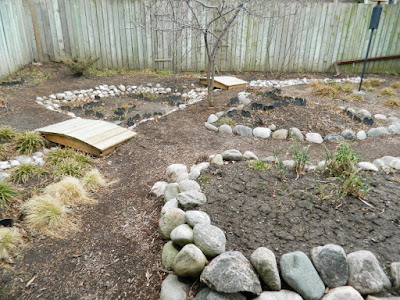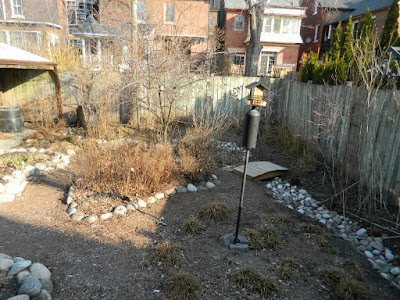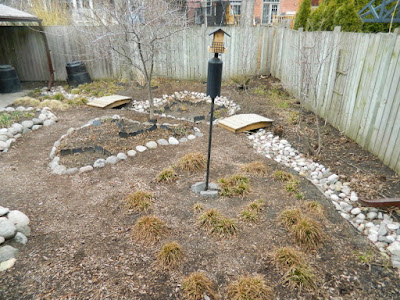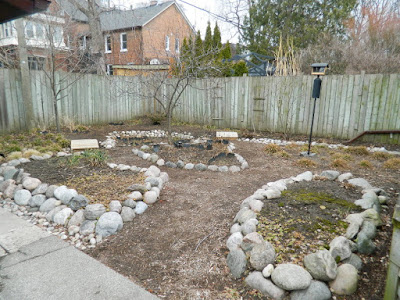A Fall Cleanup, done in Spring
It's April, finally, but feels like March here in Toronto. I don't think daytime temperatures have exceeded 10 degrees Celsius this year yet but some brave crocuses, snowdrops and winter aconites have managed to emerge and bloom. After a four month sabbatical/hiatus/hibernation, I'm slowly easing into seeing new and old clients in preparing their gardens for spring. In the landscaping or gardening business, what's called the "spring cleanup" is, more or less, the same process as the "fall cleanup" occurring the previous autumn: raking out leaves from garden beds and lawns and cutting away dead perennial stalks.
Between you me and the lamp post, a fall cleanup is usually unnecessary and detrimental from ecological and design perspectives: removing seedheads and berries means no food or habitat for overwintering birds and insect eggs and no chance for you to appreciate the winter interest that stalks and branches provide. All in the pursuit of garden "cleanliness", to various degrees.
Now, perhaps some of you are grumbling "well, why do you ("you" as in the author, which is "me", confused?) spend all autumn doing this kind of work and actually charging people, you darn hypocrite?", etc..That's a fair question but people (a.k.a. customers, homeowners, neighbours) like what they like and out of peer pressure or a sense of tidyness, these individuals prefer their gardens somewhat neater going into winter. And, of course, I have no reservations charging them and solving their problem.
But when would I tidy up things in my own garden? In the spring, certainly. Now's the time to cut away dead material to allow new stems to push up and not to compete visually with last year's growth. (I find this especially true for ornamental grasses.) It's also a great time to see the branching structure of your shrubs and trees before they leaf out in a couple of months. You can now decide to prune dead, diseased or interfering branches more easily instead of being distracted by fresh foliage and flowers later.
Anyway, I digress as usual so let's get back to this post!
 |
| Riverdale spring 2018 garden cleanup before |
I've profiled this Riverdale garden often in the past because it's unusual compared to the other Toronto gardens I look after.
Here are a couple of links if you're interested in seeing actual flowers from this garden instead of tired brown bits and pieces:
Ecological gardening in Toronto with native plants: Not your typical Toronto garden? and
Summer in Toronto: July blooms (and fruit) Flowers and fruit around town to feed the senses
The plants in the design are all native species to southern Ontario (no cultivars), there's no lawn or paved area to maintain and I don't apply any herbicides or pesticides. Aside from watering the rain garden (in between the two bridges in the photo below in the upper left corner) during the summer when we haven't had rain for more than week, the garden more or less looks after itself.
And concerning the fall cleanup? Well, there isn't one. The client prefers to leave all the stems, stalks and seedheads "up" over winter, as the "before" pictures show.
 |
| Riverdale spring 2018 garden cleanup after |
What did I clip away? Last year's growth from these perennials and others:
- Zig zag goldenrod (Solidago flexicaulis)
- Gayfeather (Liatris spicata)
- Ironweed (Vernonia gigantea)
- Foxglove Beardtongue (Penstemon digitalis)
- Cardinal Flower (Lobelia cardinalis)
- Cutleaf Coneflower (Rudbeckia lacinata)
 |
| Toronto gardening company Riverdale spring 2018 garden cleanup before |
 |
| Toronto gardening company Riverdale spring 2018 garden cleanup after |
There are several groups of sedges (Carex spp.) throughout the garden as well, one shown above. I usually clip the brown tips off in early spring as well to improve their appearance and allow room for new leaves to push through.
 |
| Riverdale spring 2018 garden cleanup before |
 |
| Riverdale spring 2018 garden cleanup after |
 |
| Toronto gardening company Riverdale spring 2018 garden cleanup before |
 |
| Riverdale spring 2018 garden cleanup after |
I can't wait until June when this garden will be loud and active with all sorts of insects and birds again, if it ever warms up.
No comments:
Post a Comment